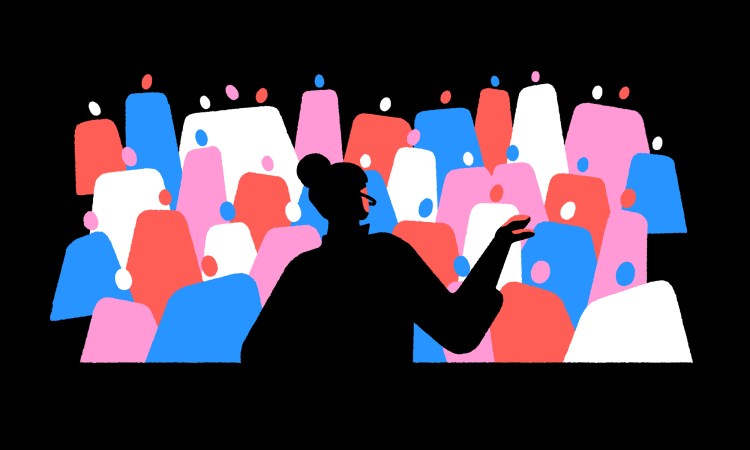
The next time you’re preparing to speak to a group, remember to keep your audience at the center of your communication, says Briar Goldberg, the director of speaker coaching at TED. One way to do this is to ask yourself: “What gift are you giving to your audience?”
TED recently partnered with Marriott Hotels to offer a special day-long seminar on public speaking for Marriott Bonvoy members. Briar Goldberg — TED’s director of speaker coaching who has helped prepare hundreds of people for the TED stage — gave them tips and tools to be better communicators in their own lives.
Below, she takes a deeper dive into one aspect of public speaking that many of us overlook when drafting our speeches and presentations: our audience.
Let’s be honest, there’s no shortage of public speaking advice out there. There are countless books, blog posts and YouTube videos offering you instructions on how to tell engaging stories, make eye contact, use hand gestures, and more. I think that’s great, although I’ll admit I’m biased. I’ve spent my career teaching public speaking and coaching executives, and since 2015, I’ve been working with TED speakers. I truly believe that everyone benefits when we communicate more effectively.
But even with so much advice available, I still see one big communication mistake made all of the time. It’s this: Most people communicate in the wrong direction.
What is the wrong direction? Too many of us write our scripts, build our decks, or compile our talking points before we think about our audience and what they need or expect to get out of our communication. This has serious consequences. When your audience doesn’t feel like your words apply to them, when they don’t understand what you’re trying to say, or, worse yet, they don’t care about your ideas, then your carefully-crafted slides, agenda or jokes simply don’t matter.
My earliest mentor in this work, Jim Wagstaffe always tells speakers to practice their ABCs: Audience Before Content. I love that acronym so much because it captures the essence of what communication is really all about — it’s not about you, the speaker; it’s always about your audience. Your audience’s needs should always be your central focus.
At TED, when we’re helping speakers prepare their talks, we ask them to identify the “gift” they’re giving the audience. In my opinion, this is what every communicator should be asking themselves before any kind of communication — whether it’s a keynote or a TED Talk or something smaller like a pitch to your boss or a statement at a community meeting. What gift are you giving the audience?
The good news is, understanding how to put your audience at the center of your communication isn’t rocket science. And when you do it correctly, I can almost guarantee that your next speech, presentation or meeting will be a success.
What does it really mean to know your audience?
You’ve probably heard the phrase “know your audience.” I’ve even seen lists floating around that offer a series of questions designed to help you do this, with queries such as: “What’s the gender breakdown of your audience?” “Are they executives or middle-managers?” “Where are they from?”
While demographic information like this is important — for example, you should probably rethink a joke about swiping right if the average age of your audience is 76 — the kind of knowledge I’m talking about goes much deeper. It goes beyond the superficial to zoom in on these two key things: “What are my audience’s goals?” and “How do they make decisions?”
How to really understand your audience’s goals
This means you’ll need to ask a different set of questions — ones that get at your audience’s needs and expectations. These include:
“Why are these people taking time out of their busy schedules to listen to me speak?”
“What do they hope (or need) to gain from this presentation/speech/address/meeting?”
“What are their expectations coming in?”
“What can I say in order to meet or exceed those expectations?”
Once you know the answers to these questions, you can craft a communication that is tailored to your audience; when you do, your audience is more likely to stay focused, remember what you said, pass on the information you shared, and remember you as a good speaker.
But what happens if your goals as a speaker don’t align with the audience’s goals?
As a communicator, you will have your own goals. Perhaps you’re an executive and you have an important message that you need the rest of the company to hear. Maybe you’ve designed a new product that you want your customers to get excited about. Getting clear on your own communication goals is important because then you can evaluate if your goals line up with your audience’s goals. If they do, that’s great — and you can start crafting your communication.
But sometimes they won’t. When this happens, it’s your job to figure out how to close the gap and persuade the audience that your goals can — and should — be their goals, too. I’m not talking about manipulation or asking you to trick people into thinking something different. What I am advocating is that you work to understand your audience well enough to know how they make decisions and what kind of information they need to have to be persuaded of their own accord.
One of the most persuasive TED Talks this year was delivered by sleep expert Matt Walker. Everyone has different goals when they decide to watch a talk about sleep. But Matt was clear on his goal: to convince people to prioritize sleep above all else. To get the audience on his side, he had to persuade them that getting enough sleep is the single most important thing they could do with our time.
Understand how your audience makes decisions
You can’t effectively persuade anyone unless you know what kind of information they need to make a decision. Think about it this way: If a salesperson was trying to sell you a new computer, you wouldn’t decide to buy it until they told you the price. With your audience, you can’t expect to influence them until you provide them with the information they need to decide if they want to change their minds.
But every audience is different. How do you know what kind of information you need to offer in order to sway them? There are entire bodies of research that cover audience persuasion strategies. But let me offer a simple framework to get you started.
In general, audiences can be broken down into three types: expert, novice and mixed. An expert audience understands your topic and they might already know you, the speaker. If you’re a real-estate broker addressing an annual meeting of the nation’s realtors, you’re speaking to an expert audience. A novice audience doesn’t know much about the topic and doesn’t know anything about you. An example of this would be a real-estate broker speaking at an open-house for community residents interested in buying a first home. But more often than not, your audience will be a mix of experts, novices and everyone in-between. The large, international TED audience is a perfect example of a mixed audience.
When you’re speaking to an expert audience: Use logical/quantitative arguments to persuade them.
In general, expert audiences are more likely to be persuaded by logical arguments and quantitative information. If you’re a real-estate broker trying to convince your expert audience to invest in a new kind of property, you’re more likely to be successful if your presentation is built around data and statistics that support this plan.
When you’re speaking to a novice audience: Lean into your own credibility.
Because a novice audience doesn’t know much about you or your topic, they tend to make decisions based on your credibility and the credibility of your sources. Therefore, it can be important to build up your reputation and credentials so they’ll trust what you’re saying and follow your recommendations.
When I’m giving a lecture on public speaking to a group who doesn’t know me, I always mention the universities I’ve taught at and some of the names of executives I’ve coached. This isn’t to brag — and let me be clear, you’ll need to use your judgement to figure out how much information to give so it doesn’t sound like you’re bragging — but it’s a quick way for me to get my audience to accept that I’m a solid source of communication advice and that they should listen to me. In some cases, I’ll tell my audience where a particular piece of information in my lecture came from. By saying “Harvard published this study last year…” I’m referencing a respected source, which reinforces my credibility as a speaker.
When you’re speaking to a mixed audience: Appeal to their emotions.
Emotional appeals can be very persuasive, especially when you’re speaking to a mixed audience. After all, everyone has made a decision based on their emotions at one point or another in their lives. Last year, TED speaker Nora McInerny shared her own experience with death to teach us about moving forward with grief. It was an A+ example of an emotional appeal.
OK great, but how do I find out all this information about my audience?
Well, that’s part of the fun. OK, maybe it’s not always fun but it is your responsibility to take a deep dive into your audience, their needs, and their motivations and — trust me — this work will pay off ten-fold. If you’re speaking at an official conference or meeting, I recommend starting with the person or organization who asked you to speak. What can they tell you about the audience? Are they willing to share any of registration information? How did they market the event? If you’re speaking on an earnings call, what about the analysts who follow your company — have you ever asked them what they need or want? If you’re speaking at your company’s town hall, can you talk to your team and find out what they expect to hear from you? If you’re speaking at an event in another country, can you find a translator or local who can help you better understand the expectations of that audience?
The information is out there — you just need to find and use it. You’ll know when you’ve done it right, because your audience will stay engaged and, when you’re done speaking, they’ll help pass your message along.
This post is part of TED’s “How to Be a Better Human” series, each of which contains a piece of helpful advice from someone in the TED community; browse through all the posts here.














